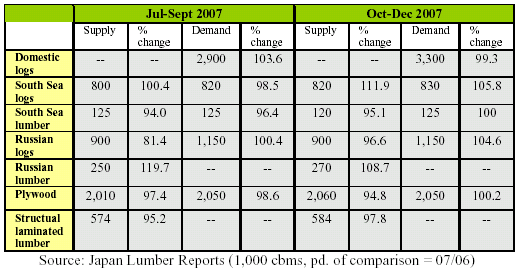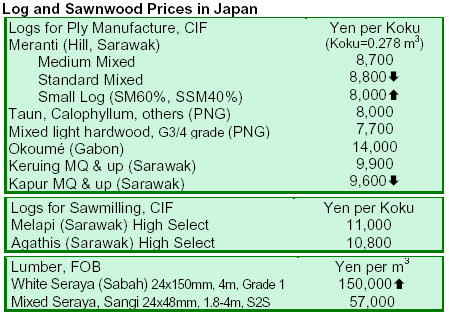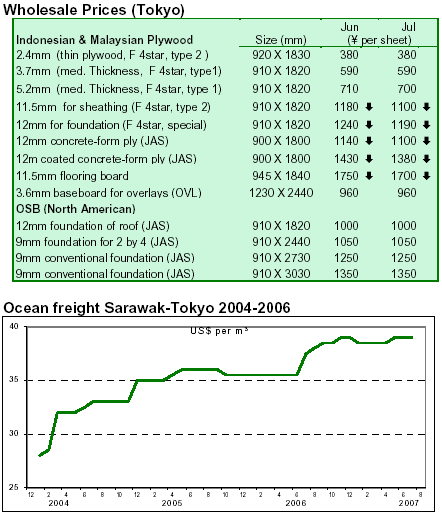|
Japan
Wood Products Prices
Dollar
Exchange Rates of 16th July
2007
Japan
Yen 118.95
Reports
From Japan
JFLA holds training on procuring legal wood products
The Japan Federation of Lumber Associations (JFLA) trained corporate employees on the
procurement of legally verified wood products, citing examples of Japanese
companies that had green procurement policies or did not work with companies involved in unsustainable practices.
Of the cases noted, Sumitomo Forestry Co. Ltd., Sekisui House, Oji Paper, Nippon Paper and Kokuyo and Askul
were identified as having strict measures in place to stop illegally harvested products from entering their supply
chain. Construction groups such as the Japan Federation of Construction Contractors and Japan Civil Engineering
Contractors’ Association had started tackling green procurement. House builders had noted the importance of
domestic wood, confirmation of legality and sustainable plantation resources. Paper manufacturers and office
supply companies have traced raw materials and certify products.
Sumitomo plans to exclude illegal products by 2009
By 2009, Sumitomo Forestry Co. Ltd. plans to exclude all illegally harvested wood products
from its business. Since the government procurement policy to encourage the
selling of environmentally friendly products was enacted, Sumitomo Forestry has aimed to procure legally verified
wood, build a highly reliable supply chain, effectively utilize resources, reduce
environmental impact and improve its relationship with stakeholders. By the end of
2007, Sumitomo will confirm the legality of its suppliers and then create standards for sustainable
forestry in 2008.
In addition to verifying the legality of its products, it also aims for consolidated sales of 1.6
trillion yen and profit of 80 billion yen by 2017. Additionally, its overseas business
will invest 10 to 20 billion yen each year in Asia, Oceania, and North America to secure timber resources and
increase wooden board production capacity. Sumitomo’s goal is to produce 1 million cbms each of MDF and
particleboard in its strategy.
Tomakomai port makes request for quicker shipments of inventories
The Port of Tomakomai in Hokkaido recently urged to cargo holders of wood products to
expedite shipments of inventories at the port. The port sent official notice to
importers indicating that ships have to wait until more spaces are available or importers must remove the same
amount of inventory as they are shipping to the port. Theport may refuse new cargo if the
importers do not agree tothe conditions, which has taken effect on 20 July.
JFA issues new forecasts on wood for 2007
New forecasts by Japan’s Forestry Agency show supply and demand projections for the
remainder of 2007. Of note, housing starts are slightly lower from 2006, at
1,260,000 units. This will impact demand for South Sea logs. However, Russian log imports may be affected by
the higher log export duty, which in turn will increase demand for Russian lumber. While demand for plywood
may be down, demand for softwood plywood could be firm. Higher costs may affect
imports of lumber, plywood and logs, since higher costs pushed domestic log
production up during the first quarter.

High hopes on cooperative to boost forest industry
By April 2008, the government hopes that a new lumber cooperative, Kumamoto Lumber
Cooperative, will boost Japan’s forest industry. As part of the Forest Agency’s
“new production system”, the cooperative will consume 4,400 m3 of local cedar logs and will eventually generate
JPY2,334 million yen. The coooperative will be subsidized by the government’s biomass
promotion policy.
On the distribution side, the Forestry Agency’s “new distribution system” has ended its
three-year run. The initiative provided government grants to businesses in an
effort to promote utilization of domestic resources for plywood and laminated lumber. The total amount ofdomestically consumed species by the subsidized facilitieswas 1.21 million m3.
Domestic wood use on the rise
The Japan Forest Products Journal reported that of 46 wooden house builders, 16 noted steady increases in
domestic wood in post and beam construction. The other builders noted they had not maximized the use of domestic
species (despite their uniform quality) due to insufficient volume and high prices. Yet, for some, the higher cost ofimports outweighs the negative aspects of domestic timber
use, and a balance of price, quality and volume will beimportant predictors of future use of domestic wood.


|